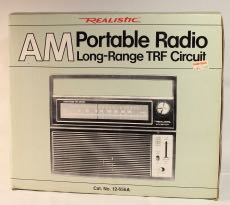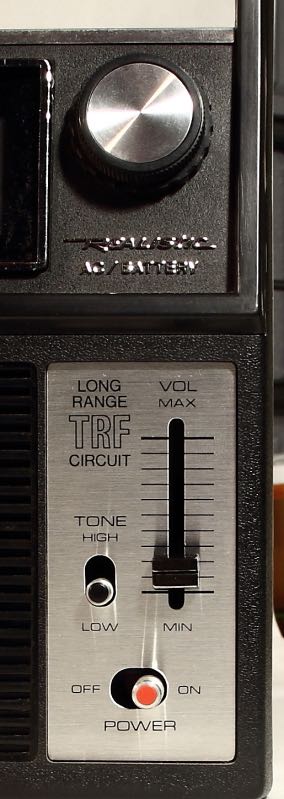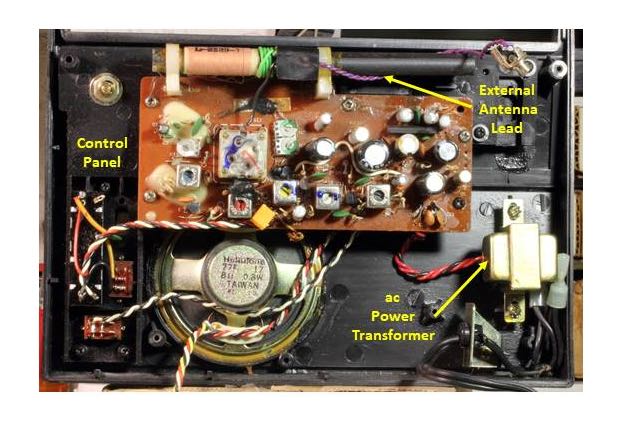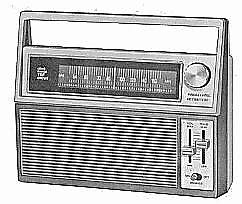Many thanks to SWLing Post contributor, Bob Colegrove, for the following guest post:
Remembering the Radio Shack TRFs
As recalled by Bob Colegrove
There has always been an interest in DXing on the cheap. At the same time, most of us don’t want to sacrifice any more capability than necessary. In the late 1970s and the early 1980s, Radio Shack provided an attractive answer to this conundrum for medium wave DXers. These were identified respectively by their Radio Shack stock numbers 12-655 and subsequently the 12-656A. I remember them being very popular among National Radio Club members of the time.
These radios were commonly known by their sobriquet “TRF.” Initially applied by Radio Shack itself, the term stuck. TRF stands for tuned radio frequency receiver. In the early days of radio, the term referred to the necessity for the operator to manually put an RF amplifier stage on frequency by adjusting the value of a variable capacitor or inductor. As amplifier stages became cascaded in two or three stages, this became a real problem, as each stage had to produce the correct frequency before anything could be heard. Eventually, designers hit on the idea of mechanically connecting all the RF stages together so tuning could be accomplished with a single knob.
Fast forward to the standard AM radios of a later generation. Entry level (read cheap) radios were limited to two stages consisting of a converter and an oscillator. This was standard design practice during the vacuum tube and transistor eras. Better, more sensitive radios added a third stage, an RF amplifier operating ahead of the converter stage. Obviously, this required more circuitry and, consequently, more expense.
Enter the Radio Shack TRFs. The term TRF was a throwback to the days of the tuned radio frequency radios and referred specifically to Radio Shack’s addition of an extra RF amplifier ahead of the converter stage. The TRFs were by no means the first radios to have this feature, but they were obviously marketed to folks who wanted longer than normal distance reception. Further, the radios were AM only uncompromised by FM circuitry, which would have to be integrated into the design and provide a distraction at best and a performance compromise at worst.
I didn’t discover these treasures until late in their production cycle. Consequently, my comments are mostly focused on the 12-656A. In later times, the -656A retailed for $34.95. On final clearance this dropped to $25, and I snapped up several for my friends and my own tinkering. The internal layout was not especially good for repair or modification, but at least was well within this enthusiast’s capability.
The picture below shows the dial of the -656A. The radio was designed prior to the expansion of the AM broadcast band to 1700 kHz; thus, it is only specified to cover 520 kHz through 1620 kHz. Although I don’t recall ever having tried it, the circuitry could possibly be coaxed to 1700 kHz. On one of my “hot rod” units, I replaced the silk-screened dial with a plain piece of Plexiglas backed with a hand-calibrated dial, which permitted accurate calibrations for 10-kHz channel identification. The tuning knob and dial cord mechanism work very well right out of the box.
The controls are aligned along the right front side of the radio. Below the tuning knob are tone and volume controls followed by an off/on switch. The 655 is similar, except the tone switch is replaced by a slider potentiometer like the volume control. In retrospect, the off/on switch should have been recessed into the front panel, as it is easy to accidentally turn on the radio with the protrusion of the switch.
The back of the cabinet (below) features standard 1/8” phone jacks for earphones (left) and an external antenna (right). The TRFs may be powered by either four C cells or from 115-Vac mains. Rather than having a separate 6-Vdc wall wart, the ac power supply components, cord and all, are contained inside the radio. For storage, the power cord is simply wrapped up in its own compartment next to the battery compartment.
Below is a tinker’s view of the innards of a -656A. Could the box have been made smaller? Obviously, one could replace the internal ac power components with a wall wart. Perhaps the C batteries could be replaced with AAs. Problem is with the speaker. The PC board hides a large drum for the tuning mechanism. Given the smooth tuning and large dial, the tuning arrangement is not something I would compromise. So, stacking the speaker with the PC board would require a much thicker box.
The external antenna uses the standard approach of a small transfer coil wrapped around the ferrite bar for signal transfer. Just as an aside, keep in mind for any long- or medium-wave radio having an external antenna coupled to the internal ferrite bar, the ferrite bar will remain active with the external antenna attached. The external antenna is effective only to the extent that the phase and amplitude of its signal compliment or reduce that produced by the ferrite loop.
In addition to two intermediate frequency (IF) stages, the circuitry includes a 455 kHz ceramic filter in the base circuit of the first IF stage. This provides very good selectivity. Never satisfied the way things are, when I first got these radios, I duplicated a third IF stage in one of the units. The result was a nice tight bandwidth still providing good audio.
The “improvements” in the -656A seem to be focused on the reduction of production costs. I’ve already mentioned the tone switch for one. Another example is the replacement of discrete components in the -655’s audio amplifier with a whopping 0.5-watt integrated circuit in the 656A. Having no way to make a performance comparison, I will say my experience with the -656A is that it is still a very hot radio.
The TRFs filled a relatively minor marketing niche, namely DXing enthusiasts and perhaps a small number of expatriates who wanted to listen to broadcasts from their old hometowns. The format evolution of medium wave broadcasting was already well on the way toward news-talk-ethnic broadcasting, and the appeal to rock ‘n rollers or virtually any music lovers just wasn’t there. A sensitive radio had to include an FM band. So, the TRFs faded into history sometime in the early ‘80s.
Enter the long-distance “superadios,” notably General Electric’s Superadios I, II, and III in the 1990s. Radio Shack itself produced a clone-like Optimus 12-603. The “super” by that time referred more to the audio quality than the sensitivity. This later generation featured two higher-quality speakers packaged in a cabinet with somewhat better acoustics, separate base and treble controls, all driven by a higher-powered audio amplifier.
Having worked in the industry for a couple years as an assembler, I have never been convinced that inclusion of multiple band coverage does not result in some performance compromise. Radios such as the TRFs have a special appeal to me. The General Electric P780 is another well-regarded example of an AM-only, high-sensitivity, radio. Maybe you have a favorite of your own. If you’re into tinkering, and even if you’re not, a functional TRF or such radio can provide a lot of cheap entertainment.








I had a 12-656A. USed it a lot and it received great.
At the time, there was a single-chip frequency counter mod published by one of the clubs that people were doing to their Radio Shack TRFs. I bought the plans, ordered the chip and got some 7-segment LED displays and tore the tuning dial out of radio and put the LED displays in it’s place. I had a radio with exact digital frequency readout!
Except…. The circuit caused very loud RFI. I had to put a power switch in to turn off the circuit when I wanted to actually listen to the radio, and turn it on only long enough to see the frequency…
I bought one of these radios back in 1979 or so. I was in high school (yet still a radio geek) and we lived in CT at the time. This radio did indeed outperform anything else I had on hand – it was comparable to a solid auto vehicle AM radio. Most of which were still quite good back then. From west of Hartford, during the day I recall pulling in anything from NY City quite well, WBZ well, also WGY and a weaker but still audible WRKO. It managed stations that other rigs I had at the time struggled with. So it was the read deal.
I haven’t lived in that area in decades and couldn’t tell you whether today’s C Crane radio would be superior to this rig. I suspect it would be a little better. But, for the price tag, the old Radio Shack “long distance” TRF was really unbeatable. Very selective for it’s time too.
Thanks so much for that Art Bell C2C link. I am loving it (sill listening). I SO miss Art. Anyway, are there any pirate radio broadcast happening these days?
73
Well thanks. That confirms my excellent judgement! I have an SR3. It was hardly used but kept on a window sill so I seem to have some corrosion since I can’t turn it on. Haven’t opened it yet. Does anyone have a service manual ( or any ideas?).
I remember rushing home from Radio Shack to get set up for grey line and testing it out.
I added 17 new stations that evening and my mother lost a lazy Susan that night
NICE!!!! I have one, and recorded off-air shows with mine. But, if you want to go further on knowing and improving this portable, check this dude’s site out: http://earmark.net/gesr/12-655.htm Yeah!!!! Has the service Manual at the bottom. And, for what it sounds like, I had two friends interviewed by Art Bell on C2C AM, and used this portable and a Pioneer cassette deck to do it. I think that they came out nice. https://archive.org/details/pat-murphy-roger-skinner-interview-on-art-bell-3-1998-edited and https://archive.org/details/andrew-yoder-on-art-bell-c-2-c-am-mon-9-10-2001-edited Enjoy!!!!!!!
R Bruce Carter also has done an interesting video comparison of AM long distance day time reception by various respected radios, including a 12-655
R Bruce Carter aka earmark,
a Texas based analog circuits engineer has put helpful 12-655 info online, and has done a number of mods on them.
https://earmark.net/gesr/12-655.htm
As I recall, Radio Shack promoted these in the catalog as ussful for things like listening to out of state baseball games. So they saw it as having a wider audience than people listening for the sake of distance.
I’ve never had one, but some of the hype seems a bit much. I’ve had the impression that people don’t tune the AM band at night, so they have no idea of how easy it is to hear lots of stations. So if someone gets interested, they bypass the coil of wire around the kitchen radio and go straight to something like the TRF or Superradio. So when they give itgoid marks, how much of it is the radio, and just an unfamiliarity with the AM band at night?
The best am/fm radio I ever had was a Delco digitally tuned car radio, set up by the bedside.In the noneties, I was buying them for a few dollars at gatage sales. They seemed better, especially on FM.
My family had a first-gen Ford Taurus back in the day. It came with a factory *AM-only* digital tuning radio. o.0
Anyway, car radios for a long time now usually integrate a RF preamplifier to improve MW performance and the horrid impedance mismatch with a vehicle-style whip antenna. Given the low losses of even cheap coax at MW, the preamp and whip antenna basically becomes an e-field probe similar to a an “active miniwhip.”
Car radios also tend to be in enclosed metal casings, which further improves EMI/RFI shielding.